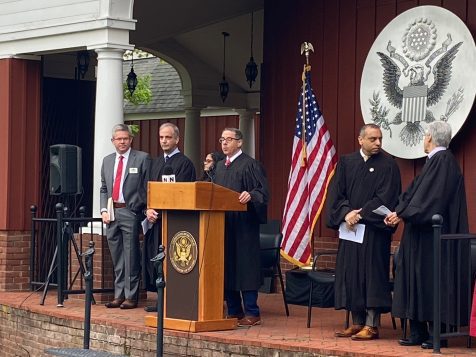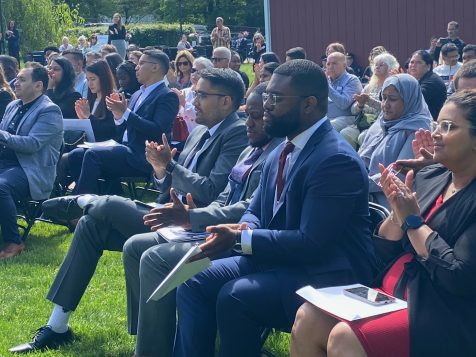Long Island Museum hosts naturalization ceremony for U.S. citizens
By William Stieglitz
Fifty citizenship candidates originating from 29 countries gathered with their families at Stony Brook’s Long Island Museum to be naturalized as U.S. citizens the morning of May 7. The countries of origin spanned five continents, including nations such as Ecuador, Israel, Nigeria and Taiwan.
The idea to hold the ceremony at the museum began with its new Building the Ballot Box exhibit, which chronicles the history of democracy on Long Island. “That project really was something that got us thinking about the possibility,” explained LIM co-executive director Joshua Ruff, noting that the Eastern District Court had held similar ceremonies at Sagamore Hill and Fire Island National Seashore. The museum then worked with the district court, alongside the Honorable Robert A. Katzmann Justice for All: Courts and the Community Initiative and U.S. Citizenship and Immigration Services (USCIS) to bring the event to fruition.
The ceremony, held on the lawn outside the carriage exhibit, began with the “presentation of the colors” for the American flag by members of the Stony Brook and Nesconset fire departments, followed by Paul J. Gelinas Junior High students singing the national anthem. A student string quintet, also from Gelinas, provided further music throughout the ceremony led by Magistrate Judge James Wicks.
Judge Wicks led the group in the call and response of the naturalization oath. The event featured four other judges, including Judge Sanket Bulsara, who led the group in the Pledge of Allegiance; Judges Nusrat Choudhury and Louis Scarcella, who distributed the naturalization certificates; and Second Circuit Judge Joseph Bianco, who attended as the keynote speaker.
Bianco told the new citizens that this ceremony was not about them losing their connections to their countries of origin, but about adding something new. “You should always hold close to your hearts your native land, its people [and] its customs… that is an extremely important part of who you are deep in your soul.” He emphasized that they should regard the United States as being as much their country as anyone else’s. “Don’t let anyone ever tell you otherwise. As of this day, your citizenship stands equal to that of every single other American.”
He encouraged attendees to become active citizens by voting in elections and aiding those less fortunate. “The truest measure of what we would call a great nation,” he said, “is how that nation treats those who are most in need — the most vulnerable, the most voiceless among all of us.” The League of Women Voters was in attendance as volunteers and said they registered about 20 people to vote.
Bianco, lastly, related his own family’s history of immigration, telling the stories of how his grandfather immigrated from Italy in the 1920s to pursue a better life, and how one of the newest members of his family, his 11-year-old son George, was adopted from China. “He’s a naturalized citizen just like you.”
Bianco elaborated on the opportunity the country gave him, and said, ”This nation provides a path for its citizens willing to take the freedom and opportunity bestowed upon them, work hard, and then watch their world light up,” he said as the clouds that had hovered all morning parted above the crowd. “Just like that sun.”
The event’s final speaker was one of the 50 newly naturalized citizens himself, Dr. Rahul Tripathi. A physician from Stony Brook Hospital, he spoke about how he immigrated from India when he was just 11 months old. “I grew up entirely in The United States,” he said. “This country raised me. I went to school here, learned how to navigate two cultures, and carried with me a quiet awareness that while I might have been born elsewhere, my future was being built here every day.”
Tripathi spoke too on the demanding nature of his job, and what his personal experiences allowed him to bring to the role. “In my training, I’ve had the privilege of caring for patients who remind me of my own family, immigrants whose first language isn’t English, who are trying to understand a complex health care system while also trying to make rent or get their children to school. I’ve been able to sit beside them not just as a doctor, but as someone who sees them, who understands the quiet bravery it takes to start over in a new country, and call it home. ”
Each new citizen was gifted a one-year membership to the museum and had the opportunity to explore the buildings. “We just want as many people as possible to come and take advantage of what we have to offer the community,” said co-executive director Sarah Abruzzi, emphasizing the museum’s variety of rotating exhibits and programming. “We do this for the community. We want everyone to feel that this is their museum.”
For many of the attendees, the path to citizenship was long. “In the past when I’ve talked to people after this ceremony, you hear numbers like 10 years, 12 years, 15 years,” said Bianco. “So that’s why there’s this joy.” Nurjahan Akter, originally from the UK, said it took her almost 10 years to become a citizen alongside her husband. Isaac Parra, another of the newly naturalized, came here from Colombia when he was 19, and is now 28.
“I left a lot behind,” said Parra. “All my family, my friends. I really had an established life back there. So it was definitely scary not knowing what was going to happen. And I’m glad it worked out this way.” He added that “it is definitely possible” for those who want to achieve the same goal. “I would encourage anyone who is seeking citizenship to apply as soon as they can.”
For more information on the Long Island Museum, you can visit its website at https://longislandmuseum.org.
For information on how to apply for naturalizstion visit www.uscis.gov.














